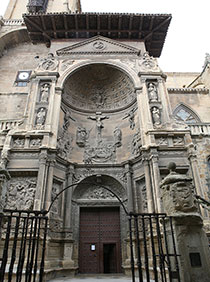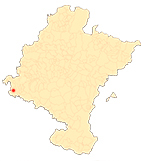Front façade of the parish church of Santa María de Viana
Home page
This doorway, which is located on the epistle side, in the section before the gable wall, was begun by Juan de Goyaz in 1549, and its construction lasted until 1570, being appraised by the overseer of works Juan Vallejo. Its construction went through three successive phases, the first between 1542 and 1552, at position of the Guipuzcoan stonemason Juan de Goyaz, a native of Albiztur but a resident of Bañares, master of royal works with Carlos I, who gave the design of the doorway, validated by the Provisor Andrés Ortiz de Urbina. On the death of Goyaz, the Biscayan stonemason Juan Ochoa de Arranotegui, a native of Arrazua, who among other things had been in charge of the appraisal of the works of the university of Oñate and the altarpiece of Peñacerrada, became position of the works. This master directed the works between 1552 and 1566, working with him other stonemasons, such as his brother Pedro, his son Juan II, Sebastián and Juan de Orbara, as well as the sculptors Arnao de Bruselas, Andrés de Araoz, Nicolás de Venero and Gaspar de Vitoria. Finally, between 1566 and 1570, the works were directed by the son of the previous Juan II Ochoa de Arranotegui, in partnership with Juan de Orbara.
It is a scenographic portal that is articulated as a triumphal arch, with a large central semicircular niche, reminiscent of the one made by Bramante in the courtyard of the Belvedere in the Vatican palaces in 1506. It presents five streets of different widths, distributed in a high plinth, two bodies and attic, with greater prominence of the central street in the form of exedra, covered by a vault of quarter of sphere decorated by means of decreasing coffers. In it is distributed a rich iconography in which the sacred is mixed with the profane, along with elements of candelieri and grotesque, all of great complexity. These sculptures and reliefs must be placed in relation to the Riojan sculpture of the time, while the decorative elements come from repertoires of fantastic Mannerism. The inducer of this iconography was probably Juan Bernal Díaz de Luco (1495-1556) bishop of Calahorra-La Calzada, a prelate who had participated in the Council of Trent and who had an important Library Services where he collected works on natural sciences and astrology, both from the classics and contemporary authors, including treatises by Serlio and Palladio.
-
ESTEBAN LORENTE, J.F., "El arco de ingreso de la colegiata de Santa María de Viana. Horóscopo de Cristo", Berceo, 130, 1996, pp. 177-178.
-
ESTEBAN LORENTE, J.F., "Los dioses paganos en las iglesias españolas del siglo XVI", bulletin del Museo e high school Camón Aznar, LXXXII, Zaragoza, high school Camón Aznar, 2000, pp. 157-190.
-
FERNÁNDEZ GRACIA, R., (coord.), ECHEVERRIA GOÑI, P.L., and GARCÍA GAINZA, M. C., El arte del Renacimiento en Navarra, Pamplona, Gobierno de Navarra, 2005, pp. 111-114.
-
GARCÍA GAINZA, M. C., HEREDIA MORENO, M. C., RIVAS CARMONA, J. and ORBE SIVATTE, M., Catalog Monumental de Navarra. V. II**. Merindad de Estella, Pamplona, 1980, pp. 559-564.
-
GONZÁLEZ DE ZÁRATE, J. M., "Aproximaciones a la lectura iconográfica del programa mitológico en la portada de Santa María de Viana", Primer congress General de Historia de Navarra, anejo 11, Pamplona, Príncipe de Viana, 1988, pp. 179-196.
-
LABEAGA MENDIOLA, J.C., Viana monumental y artística, Pamplona, Príncipe de Viana, 1984, pp. 229-236.












